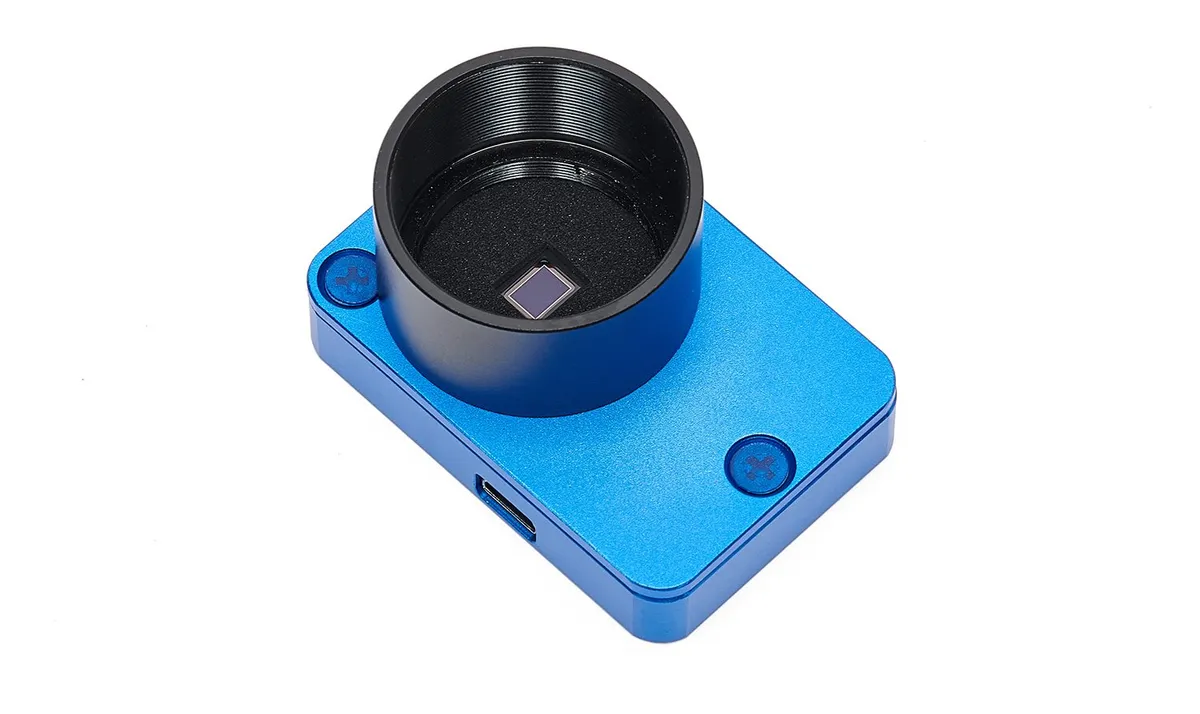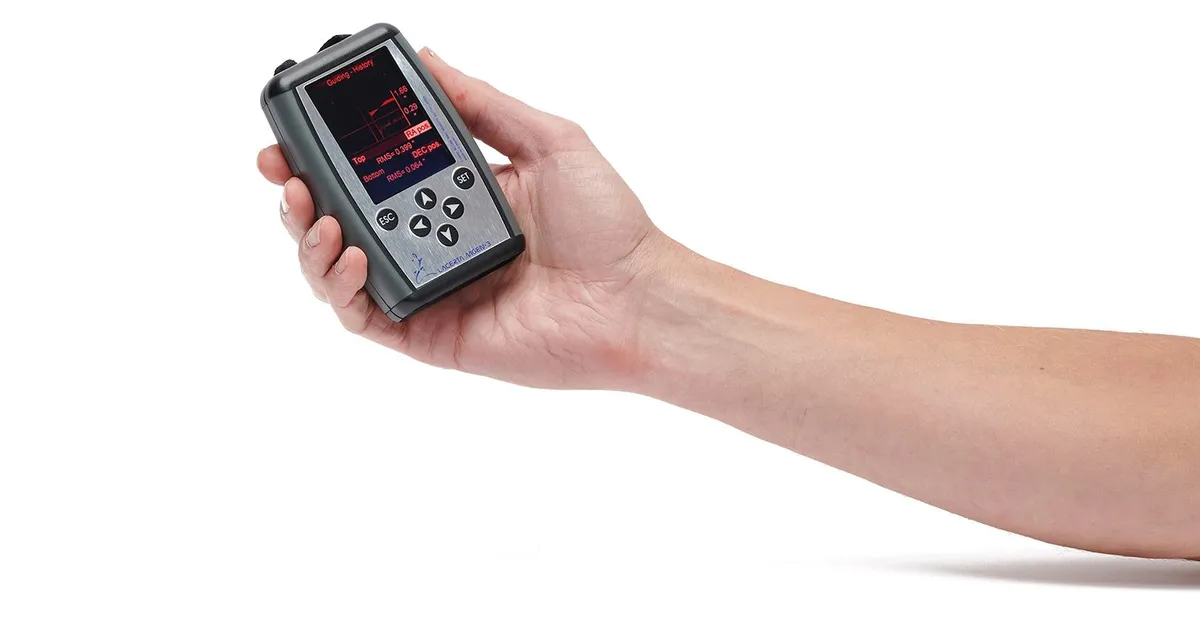The Lacerta MGEN-3’s simple alternative to ‘full-on’ guiding, one where a laptop and additional software isn’t needed, is exciting.
Opening the MGEN-3’s box we were surprised by the lack of components. There’s the autoguider control box (a lightweight 40g), a 1.2MP guide camera, two USB leads and an ST4 guiding cable.
Adaptors for different setups are also provided with the camera, providing up to 26mm backfocus for different configurations. No paper instructions are provided but there’s an easy-to-follow manual on the website.
The MGEN-3 builds on its predecessor, the MGEN-2, by offering improvements including multi-star guiding to reduce atmospheric distortions, and a ‘one-push’ autoguiding function.
It also offers DSLR/CCD exposure control in place of an intervalometer, along with built-in ‘drift (polar) alignment’ and ‘dithering’ functions.
‘Drift alignment’ helps those unable to view Polaris from their imaging location, while ‘dithering’ creates minute movements of the camera between exposures, to reduce noise – unwanted artefacts – in an image.

After fixing the camera to our guidescope, we only had to link it to the control box, and the control box to our mount and power via the supplied cables.
The ‘Esc’ button on the control box led to the main menu and, after adding the focal length of our guider, we navigated to ‘Imaging’, which shows a live image to help focus.
The ‘one-push’ start button function immediately started picking up guide stars, meaning we were ready to begin.
We found the camera sensitive even in summer twilight – it picked up 70 guide stars for the North America Nebula with our 50mm guiderscope.
We put the MGEN-3 through its paces with a 10-minute exposure, noticing round stars were kept consistently round. This was great for something we had plugged in with almost no adjustments and polar alignned completely manually.
Guiding graphs were clear, and we noted that the arrow buttons on the control box flashed to signify the directional adjustments the MGEN-3 was making, which was a nice touch.
Each time we used the kit, it took about five minutes for the graphs to settle into a consistently smooth guiding pattern.

The MGEN-3’s ‘dithering’ function is also simple to use. It’s adjustable, but we opted for the default setting of 10 pixels and obtained significantly reduced noise in our final DSLR image.
We shot the North America Nebula with ‘dithering’ enabled and the Elephant’s Trunk Nebula with it disabled, and noted significant difference.
Browsing through the various menu options, we saw that declination can be switched off, which allows for use with a number of portable tracking mounts – another good feature for beginners.
In terms of add-ons, we particularly liked the dark frame routine, which applies dark frames to remove hot pixels from the guide camera image and reduces the risk of interrupted guiding.
Essentially, the MGEN-3 comes with everything needed to guide quickly, accurately and reliably, without a laptop and mains power – we didn’t feel we were missing anything from our regular guiding routine.

While the interface is basic, there are several calibration settings provided to adapt for more advanced imagers, meaning this kit also has plenty to offer more experienced astrophotographers.
Lacerta is looking to add additional features via firmware updates and these will be free for a year after purchasing. Under investigation is plate solving, which we would be keen to see.
The Lacerta MGEN-3 autoguider is engineered to be as easy as possible to use, and if future functions adopt the same straightforward approach, it will continue to hold its own among heavyweight guiding equipment.
The ‘stand-alone’ element of the MGEN-3 autoguider is impressive. We found the equipment completely plug-and-play and the control box comes with a ‘live view’ function in place of a laptop screen. Once attached to the guidescope, we were up and running within minutes.
When you go the conventional, laptop-driven route, common problems can include incorrect drivers, lack of USB ports, cable management and disconnection issues. With the MGEN-3 we encountered none of these.
There is the option, though, to connect via a laptop (and Lacerta provides apps to do this), which means you can get used to laptop-controlled setups before moving up to the standalone integrated guiding equipment and software.
The flexibility means we could switch between the two options, depending on the location we were imaging from, and this makes the MGEN-3 even more adaptable.
Overall, we couldn’t think of anything else that the Lacerta MGEN-3 needs to do when we compared it to specialist guiding software.

LCD display
The crisp, colour LCD screen is easy to read and navigate. The four main menus comprise DSLR exposure control, ‘one-push’ guiding, functions and calibrations, and display customisation. The layout of the menus is similar to that of a DSLR, so it will feel familiar to many users.
Artificial Intelligence (AI) programming
The AI programming can capture up to 100 stars in the camera’s field of view, allowing for a greater guiding accuracy of 1/50 pixels. Combined with the camera’s sensitivity, we were able to detect enough stars to maximise exposure times for our DSLR, even in lighter summer skies.
Handheld control box
The controller fits nicely in the palm of the hand and comes with an LCD display and simple push-button design. Despite its small size, it packs a punch, with a 32-bit CPU and 64MB RAM. Control buttons are backlit with red lighting, making it easy to change settings in darkness.
Ports
All ports are located at the base of the control box and include a DSLR out, AUX, USB (for connection to the guide camera) and an ST4 guide port. There is also USB-in for connection to a power source. As the MGEN-3 draws about 240mA, it can be powered via a portable powerpack.
Guide camera
The compact, sensitive guide camera is designed to fit any guidescope. Its sensor, the monochrome AR0130CS, provides 3.75µm pixels across an area of 4.8mm x 3.6mm. Its aluminium casing allows passive cooling to reduce noise, while the MGEN-3’s zoom function enables more precise focusing of the guide camera via the guidescope.
Vital stats
- Price £609
- Weight 1.1kg
- Controller Handheld control box
- Camera 1.2MP, 1280 x 960, CMOS AR0130CS monochrome guide camera
- Extras 4GB micro SD card, camera adaptors, cables
- Software Virtual Interface and Sky Emulator PC applications
- Supplier 365 Astronomy
- Tel 020 3384 5187
- www.365 astronomy.com
This review originally appeared in the September 2020 issue of BBC Sky at Night Magazine.
